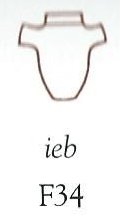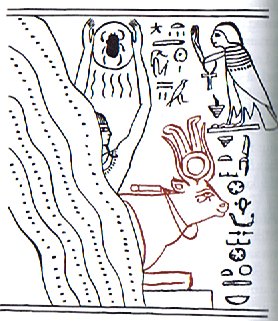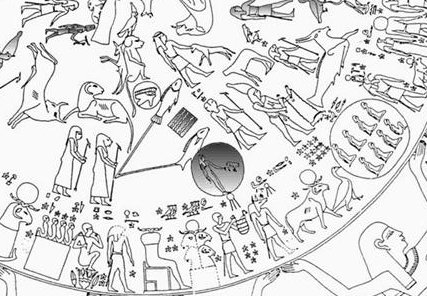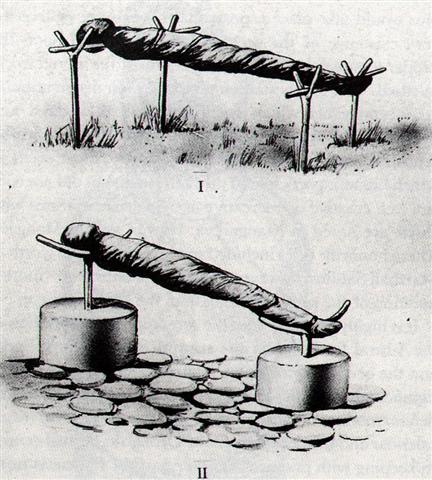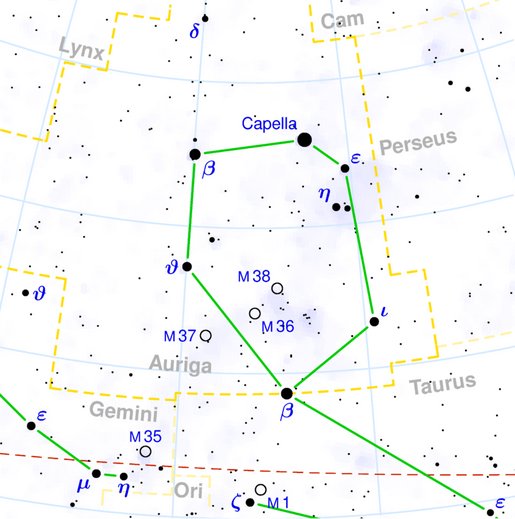Possibly it was necessary to have 3 men present for creating a king (haka-ariki) - to install a new king beyond the dead old one:
When Achernar was at 0h the position of the Weight star (Wezn, β Columbae) should have been in day 144 (= 12 * 12), i.e. in MAY 24.
... In the inscriptions of Dendera, published by Dümichen, the goddess Hathor is called 'lady of every joy'. For once, Dümichen adds: Literally ... 'the lady of every heart circuit'. This is not to say that the Egyptians had discovered the circulation of the blood. But the determinative sign for 'heart' often figures as the plumb bob at the end of a plumb line coming from a well-known astronomical or surveying device, the merkhet. Evidently, 'heart' is something very specific, as it were the 'center of gravity' ... See Aeg.Wb. 2, pp. 55f. for sign of the heart (ib) as expressing generally 'the middle, the center'.
And this may lead in quite another direction. The Arabs preserved a name for Canopus - besides calling the star Kalb at-tai-man ('heart of the south') ... Suhail el-wezn, 'Canopus Ponderosus', the heavy-weighing Canopus, a name promptly declared meaningless by the experts, but which could well have belonged to an archaic system in which Canopus was the weight at the end of the plumb line, as befitted its important position as a heavy star at the South Pole of the 'waters below'. Here is a chain of inferences which might or might not be valid, but it is allowable to test it, and no inference at all would come from the 'lady of every joy'. The line seems to state that Hathor (= Hat Hor, 'House of Horus') 'rules' the revolution of a specific celestial body - whether or not Canopus is alluded to - or, if we can trust the translation 'every', the revolution of all celestial bodies. As concerns the identity of the ruling lady, the greater possibility speaks for Sirius, but Venus cannot be excluded; in Mexico, too, Venus is called 'heart of the earth'. The reader is invited to imagine for himself what many thousands of such pseudo-primitive or poetic interpretations must lead to: a disfigured interpretation of Egyptian intellectual life ...
May 24 (at the time of rongorongo) coincided with the beginning of side a on the G tablet (where the 5th Chinese station Heart was close to the Full Moon) and on side b there was a hakaariki at Gb5-24 - a position which well could have alluded to MAY 24 (5-24):
The cycle of Jupiter was ca 399 days and at the time of Bharani Haedus II rose with the Sun 399 days after "March 21 in the previous year.
The Chorti diviners could therefore have referred to "April 25 (115) for the day when their sky raising ceremonies were beginning: ... Later on in this series of rituals, the Chorti go through a ceremony they call raising the sky. This ritual takes place at midnight on the twenty-fifth of April and continues each night until the rains arrive. In this ceremony two diviners and their wives sit on benches so that they occupy the corner positions of the cosmic square. They take their seats in the same order as the stones were placed, with the men on the eastern side and the women on the west. The ritual actions of sitting down and lifting upward are done with great precision and care, because they are directly related to the actions done by the gods at Creation. The people represent the gods of the four corners and the clouds that cover the earth. As they rise from their seats, they metaphorically lift the sky. If their lifting motion is uneven, the rains will be irregular and harmful ... (David Freidel, Linda Schele, Joy Parker, Maya Cosmos. Three Thousand Years on the Shaman's Path.) On the other hand - in a Sun calendar the dates for the Sun should never change. Notably Manuscript E has a description of 3 men failing to bring the Oto Uta stone safely ashore, possibly because Easter Island was outside the tropical belt, outside the reach of the Great Spider: ... Then three lines are drawn east and west, one across the northern section indicates the northern limit of the Sun (corresponding with the Tropic of Cancer) about the 15th and 16th days of the month Kaulua (i.e., the 21st or 22nd of June) and is called ke alanui polohiwa a Kane, the black-shining road of Kane. The line across the southern section indicates the southern limit of the Sun about the 15th or 16th days of the month Hilinama (December 22) and is called ke alanui polohiwa a Kanaloa, the black-shining road of Kanaloa. The line exactly around the middle of the sphere is called ke alanui a ke ku'uku'u, the road of the spider, and also ke alanui i ka Piko a Wakea, the way to the navel of Wakea (the Sky-father) ... ... One is reminded of Inky Pinky Spider who was climbing up the spout, but then came the rain and washed poor spider out. But Sun shone anew and dried away all rain, and Inky Pinky Spider was climbing up again ...
... At the time of the loading of the emigrant canoe, Hotu Matua ordered his assistant Teke to take a (stone) figure (moai) named 'Oto Uta' on board the canoe, along with the people (aniva) who were emigrating. However, the figure was left behind 'out in the bay' (E:73). After the arrival in the new land, after disembarkation in the bay of Anakena, and after the return of the explorers to the homeland, our source continues with the following account [E:87-90]. On the thirtieth day of the month of October ('Tangaroa Uri'), Hotu asked about the stone figure (moai maea) named Oto Uta. Hotu said to Teke, 'Where is the figure Ota Uta (corrected in the manuscript for Hina Riru)? Teke thought about the question and then said to Hotu, 'It was left out in the bay.' Hotu said to Pure O, to Pure Ki, and to Pure Vanangananga: 'You fellows (kope), sail to the friend (hoou), to Oto Uta. Bring him here, he who is resting out in the bay. Move him carefully (? nee), you fellows, so that the king, that Oto Uta is not damaged!' Pure O, Pure Ki, and Pure Vanangananga took the canoe, put it into the water, and sailed to Hiva. The canoe of Pure O left on the fifth day of the month of November ('Ruti'). After the canoe of Pure O had sailed and had anchored out in the bay, in Hanga Moria One, Pure saw the figure, which had been lying there all this time, and said to his younger brothers (ngaio taina), 'Let's go my friends (hoa), let us break the neck of this mean one (or, ugly one, rakerake). Why should we return to that fragment of earth (te pito o te kainga, i.e., Easter Island)? Let us stay in our (home)land!' ... Pure O picked up a large round stone (pureva) and hit the top of the figure. Because of the stone, the neck of Oto Uta was broken.Then the wind started blowing, the billow rose, the waves broke, the rain started falling, the flame (i.e., lightning) shone brightly, and the thunder rolled. As soon as the wind started blowing, the waves broke, the rain fell, and thunder rolled, King Hotu knew that Pure O had done harm to Oto Uta. Hotu spoke: 'These fellows have done a mean thing to King Oto Uta!' After the neck of Oto Uta had been broken, Kuihi and Kuaha arrived. They picked up the neck of King Oto Uta, took it, and brought it with them. They arrived out in the bay, in Hanga Rau. (There) Kuihi and Kuaha left (the fragment). After the neck of Oto Uta had been brought on land, out in the bay of Hanga Rau, the wind, the rain, the waves, and the thunder subsided. Kuihi and Kuaha arrived and told the king the following: 'King Oto Uta is out in the bay of Hanga Rau'. Hotu said to his servant (tuura) Moa Kehu, 'Go down to king Oto Uta and take him up out of the bay of Hanga Rau!' Moa Kehu arose, went down, picked up (the fragment), and carried (it) on his shoulders [i te tua ivi] to the house. There he left it for King Hotu. King Hotu sat down and wept over King Oto Uta. This is Hotu's lament (tanginga): ka hati toou ngao e oto uta e te ariki e / mo tau papa rangaranga o haho i te tai / mo tuu huehue rangaranga o haho i te tai / mo tau hahave rere ai ka pae / mo tae ngu rere ai ka pae / mo te ika aringa riva nei he aku renga ai ka pae Broken is your neck, oh Oto Uta, oh king! / Floating (?) like a raft (?) out at sea. / To be erected for the drifting huehue (fish) out at sea. / Able (?) to put an end to the flight of the flying fish hahave; / Able (?) to put and end to the flight of the flying fish ngu; / Put an end to this fish, a dorado, with the good face! (E:87-90) ... Close to Aquarius in the round Dendera ceiling there was a creature without head:
But in the Babylonian zodiac the heads of the Horse and the Stag were still intact:
... A man had a daughter who possessed a wonderful bow and arrow, with which she was able to bring down everything she wanted. But she was lazy and was constantly sleeping. At this her father was angry and said: 'Do not be always sleeping, but take thy bow and shoot at the navel of the ocean, so that we may get fire.' The navel of the ocean was a vast whirlpool in which sticks for making fire by friction were drifting about. At that time men were still without fire. Now the maiden seized her bow, shot into the navel of the ocean, and the material for fire-rubbing sprang ashore. Then the old man was glad. He kindled a large fire, and as he wanted to keep it to himself, he built a house with a door which snapped up and down like jaws and killed everybody that wanted to get in. But the people knew that he was in possession of fire, and the stag determined to steal it for them. He took resinous wood, split it and stuck the splinters in his hair. Then he lashed two boats together, covered them with planks, danced and sang on them, and so he came to the old man's house. He sang: 'O, I go and will fetch the fire.' The old man's daughter heard him singing, and said to her father: 'O, let the stranger come into the house; he sings and dances so beautifully.' The stag landed and drew near the door, singing and dancing, and at the same time sprang to the door and made as if he wanted to enter the house. Then the door snapped to, without however touching him. But while it was again opening, he sprang quickly into the house. Here he seated himself at the fire, as if he wanted to dry himself, and continued singing. At the same time he let his head bend forward over the fire, so that he became quite sooty, and at last the splinters in his hair took fire. Then he sprang out, ran off and brought the fire to the people ... (From the Catlo'Itq in British Columbia according to Hamlet's Mill.) Perhaps Metoro saw the horn of the Stag released at the beginning of Auriga in order to make a return at the back of the figures in MAY 15 (500) and MAY 16 (136):
... A sidelight falls upon the notions connected with the stag by Horapollo's statement concerning the Egyptian writing of 'A long space of time: A Stag's horns grow out each year. A picture of them means a long space of time.' Chairemon (hieroglyph no. 15, quoted by Tzetzes) made it shorter: 'eniautos: elaphos'. Louis Keimer, stressing the absence of stags in Egypt, pointed to the Oryx (Capra Nubiana) as the appropriate 'ersatz', whose head was, indeed, used for writing the word rnp = year, eventually in 'the Lord of the Year', a well-known title of Ptah. Rare as this modus of writing the word seems to have been - the Wörterbuch der Aegyptischen Sprache (eds. Erman and Grapow), vol. 2, pp. 429-33, does not even mention this variant - it is worth considering (as in every subject dealt with by Keimer), the more so as Chairemon continues his list by offering as number 16: 'eniautos: phoinix', i.e., a different span of time, the much-discussed 'Phoenix-period' (ca. 500 years). There are numerous Egyptian words for 'the year', and the same goes for other ancient languages. Thus we propose to understand eniautos as the particular cycle beloning to the respective character under discussion: the mere word eniautos ('in itself', en heauto; Plato's Cratylus 410D) does not say more that just this. It seems unjustifiable to render the word as 'the year' as is done regularly nowadays, for the simple reason that there is no such thing as the year; to begin with, there is the tropical year and sidereal year, neither of them being of the same length as the Sothic year. Actually, the methods of Maya, Chinese, and Indian time reckoning should teach us to take much greater care of the words we use. The Indians, for instance, reckoned with five different sorts of 'year', among which one of 378 days, for which A. Weber did not have any explanation. That number of days, however, represents the synodical revolution of Saturn. Nothing is gained by the violence with which the Ancient Egyptian astronomical system is forced into the presupposed primitive frame. The eniautos of the Phoenix would be the said 500 (or 540) years; we do not know yet the stag's own timetable: his 'year' should be either 378 days or 30 years, but there are many more possible periods to be considered than we dream of - Timaios told us as much. For the time being the only important point is to become fully aware of the plurality of 'years', and to keep an eye open for more information about the particular 'year of the stag' (or the Oryx), as well as for other eniautio, especially those occurring in Greek myths which are, supposedly, so familiar to us, to mention only the assumed eight years of Apollo's indenture after having slain Python (Plutarch, De defectu oraculorum, ch. 21, 421C), or that 'one eternal year (aidion eniauton)', said to be '8 years (okto ete)', that Cadmus served Ares ...
There are 3 flames in front of the toga horn of the Stag. Evidently this symbol survived through the millenia:
Kai viri, kai viri ('not forgotten') it was stated in Manuscript E, referring to the 3 outside islets (Nga Kope Ririva Tutuu Vai a te Taanga) in the southwest: 
... On the twenty-fifth day [80 + 25 = 115] of the first month (Vaitu Nui), Ira and Makoi set sail; on the first day of June ('Maro'), the bow of Ira's canoe appeared on the distant horizon, came closer and closer on its course, and sailed along, and finally (one) could see the (new home) land.
The canoe reached the islets (off the coast), and Ira saw that there were three such islets. Ira said, 'Hey you, crew of young men, the vision of Hau Maka, our father, which he revealed to me, has come true. There are 'the handsome sons of Te Taanga, who are standing in the water', for this is the name that the dream soul of Hau Maka gave them. Unforgotten (? kai viri kai viri) are they, these three. And therefore this is the (right) land lying there; this is Te Pito O Te Kainga, which also received its name from the dream soul.' (Manuscript E p. 17.)
|
|||||||||||||||||||||||||||||||||||||||||||||||||||||||||||||||||||||||||||||||||||||||||||||||||||||||||||||||||||||||||||||||||||||||||||||||||||||||||||||||||||||||||||||||||||||||||||||||||||||||||||||||||||||||||||||||||||||||||||||||||||||||||||||||||||||||||||||||||||||||||||||||||||||||||||||||||||||||||||||||||||||||||||||||||








